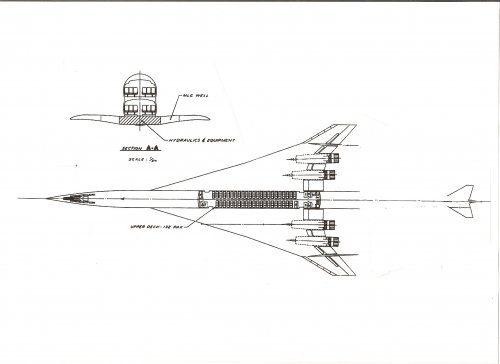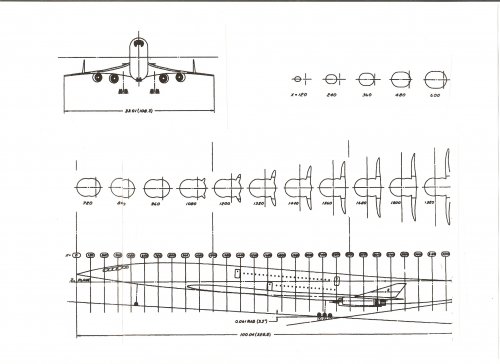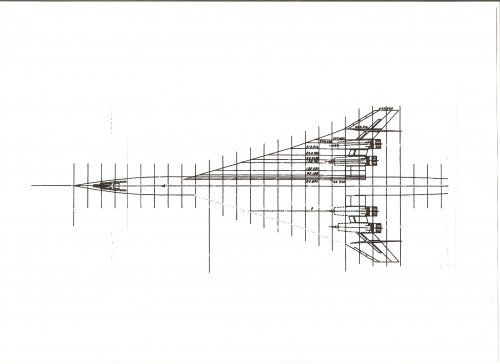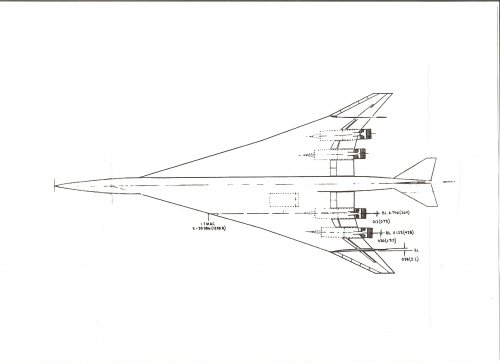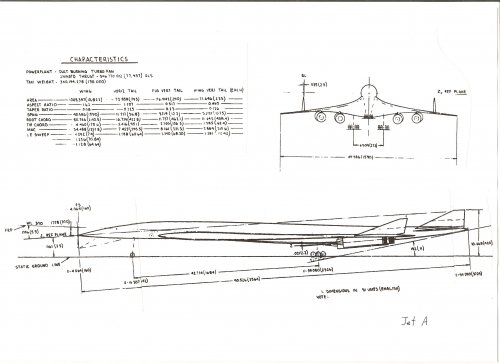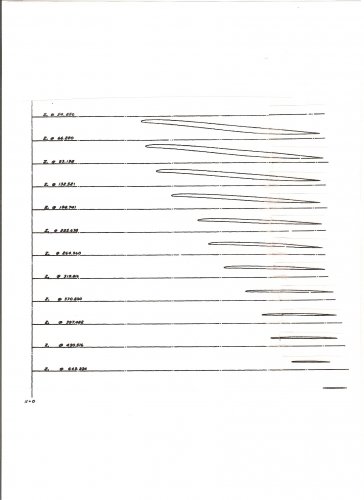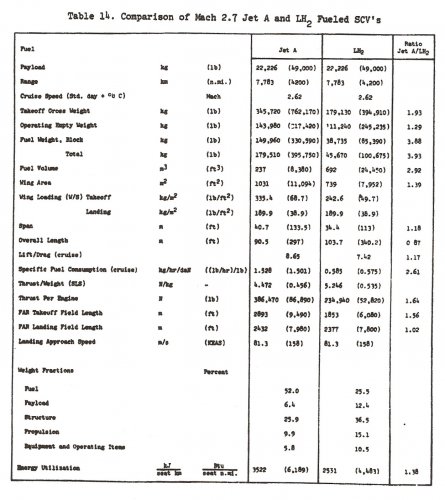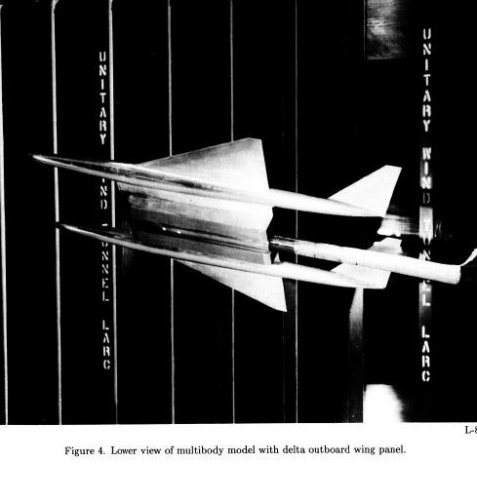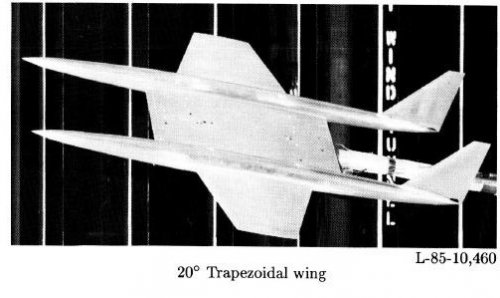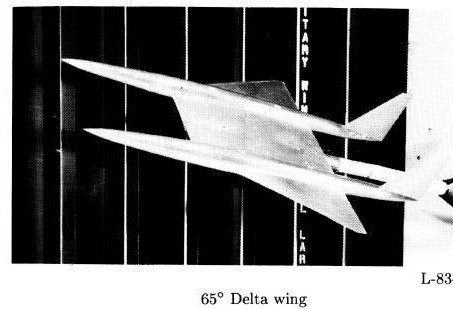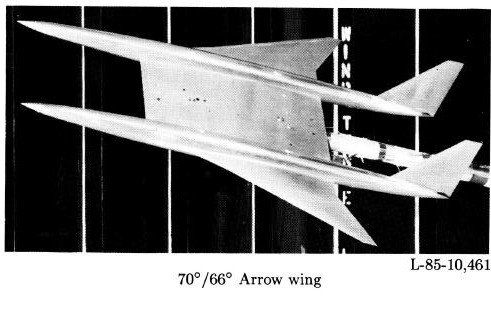You are using an out of date browser. It may not display this or other websites correctly.
You should upgrade or use an alternative browser.
You should upgrade or use an alternative browser.
US Supersonic Transport(SST) Program post-1971
- Thread starter Sundog
- Start date
blackkite
Don't laugh, don't cry, don't even curse, but.....
- Joined
- 31 May 2007
- Messages
- 8,819
- Reaction score
- 7,716
- Joined
- 26 May 2006
- Messages
- 34,894
- Reaction score
- 15,758
Attachments
Lampshade111
ACCESS: Confidential
- Joined
- 5 October 2008
- Messages
- 151
- Reaction score
- 17
I wonder if it would be possible to produce such a supersonic transport today, without the cost and maintenance problems of the Concorde.
blackkite
Don't laugh, don't cry, don't even curse, but.....
- Joined
- 31 May 2007
- Messages
- 8,819
- Reaction score
- 7,716
Anyone please show us the impression of Concorde.
I never saw and heard Concorde.
How about Mach 2 flight? How about acceleration? How about take off and landing?
(I red that landing angle of attack is 8 to 9 degree.)
Is it so noisy? How about sonic boom?
I never saw and heard Concorde.
How about Mach 2 flight? How about acceleration? How about take off and landing?
(I red that landing angle of attack is 8 to 9 degree.)
Is it so noisy? How about sonic boom?
blackkite
Don't laugh, don't cry, don't even curse, but.....
- Joined
- 31 May 2007
- Messages
- 8,819
- Reaction score
- 7,716
I study typical Concorde flight pattern.(Paris to N.Y.)
1.Take off using after burner of four Olympus 593Mk.610-28(17,243kg thrust each).
2.Cut after burner in initial clime period to reduce noise.
3.Reach altitude 7,700m and Mach 0.75(110 km from Paris).
4.Reach Mach 0.95 without after burner.(220km from Paris).
5.Ignite after burner and accelerate to super sonic speed and clime.
6.Reach altitude 13,000m and Mach 1.70(440km from Paris).
7.Cut after burner and accelerate to Mach 2.0 with dry thrust.
8.Reach Mach 2.0, altitude 15,300m, 1,225km from Paris spending 1hour).
9.Reach Mach 2.02, 5,385km from Paris spending 2hour 41minutes and begin landing preparation.
10.9minutes later, reach Mach 1.0,altitude 10,700m.
11.Reach Mach 0.95, 177km to N.Y. before 28 minutes to landing.
(Source AIR WORLD MAGAZINE December 2003.)
It's fuel consumption is very big as a sports car.
It's noise is like a rock drill.
It's sonic boom is like a thunderbolt(JAXA's report).
But it's a really super excellent airplane. It flew for 30 years safely without accident except last tragedy.
1.Take off using after burner of four Olympus 593Mk.610-28(17,243kg thrust each).
2.Cut after burner in initial clime period to reduce noise.
3.Reach altitude 7,700m and Mach 0.75(110 km from Paris).
4.Reach Mach 0.95 without after burner.(220km from Paris).
5.Ignite after burner and accelerate to super sonic speed and clime.
6.Reach altitude 13,000m and Mach 1.70(440km from Paris).
7.Cut after burner and accelerate to Mach 2.0 with dry thrust.
8.Reach Mach 2.0, altitude 15,300m, 1,225km from Paris spending 1hour).
9.Reach Mach 2.02, 5,385km from Paris spending 2hour 41minutes and begin landing preparation.
10.9minutes later, reach Mach 1.0,altitude 10,700m.
11.Reach Mach 0.95, 177km to N.Y. before 28 minutes to landing.
(Source AIR WORLD MAGAZINE December 2003.)
It's fuel consumption is very big as a sports car.
It's noise is like a rock drill.
It's sonic boom is like a thunderbolt(JAXA's report).
But it's a really super excellent airplane. It flew for 30 years safely without accident except last tragedy.
KJ_Lesnick
ACCESS: Top Secret
- Joined
- 13 February 2008
- Messages
- 1,042
- Reaction score
- 114
The technology base already exists for
- Designing fuselages of shapes and sizes that allow significant passenger-capacity, low-drag at both high and low mach-numbers, and to an extent even low-sonic booms
- Wing designs which yield high L/D ratios at high speed, low trim-drag and allow reasonably low-speeds for takeoff and landing.
- Composite-technology for wing, fuselage, and engine-pod construction which allows significantly reduced-weight over an all-metal design
- High Pressure-Recovery Mixed-Compression Inlet designs that can operate in excess of Mach 3 with no moving parts, and self-stabilization capability (The L-2000-7A was to have such an inlet)
- Engine technology which allows high-thrust, relatively compact, high pressure-ratio, highly-fuel-efficient designs with super-cruise capability, and ultra-low NOx-levels with long service-life.
- Extendable and Retractable sound-suppressors for entraining and mixing outside airflow with exhaust to produce low noise-levels with acceptable losses of thrust
- Artifical-vision technology to provide near human-eye forward vision quality without any need for a drooping nose
- Fly-by-Wire, Fly-by-Light, and even electrical actuators for moving control surfaces of which many reduce weight over a standard mechanically-signalling/hydraulic-powered design
Virtually all the things you need to produce an economically-viable SST. Unfortunately it would be very expensive to develop and most aircraft manufacturers would need government assistance to develop it. Truthfully, considering how much our government is spending/wasting pursuing unnecessary war in Iraq, if they really wanted to of course they could physically use (a lot less) the money to build an economically viable manned SST design for 300 passengers. Sure, conservatives would be having a conniption yelling "NOT MY TAX DOLLARS!", but that's another issue all together.
KJ Lesnick
- Designing fuselages of shapes and sizes that allow significant passenger-capacity, low-drag at both high and low mach-numbers, and to an extent even low-sonic booms
- Wing designs which yield high L/D ratios at high speed, low trim-drag and allow reasonably low-speeds for takeoff and landing.
- Composite-technology for wing, fuselage, and engine-pod construction which allows significantly reduced-weight over an all-metal design
- High Pressure-Recovery Mixed-Compression Inlet designs that can operate in excess of Mach 3 with no moving parts, and self-stabilization capability (The L-2000-7A was to have such an inlet)
- Engine technology which allows high-thrust, relatively compact, high pressure-ratio, highly-fuel-efficient designs with super-cruise capability, and ultra-low NOx-levels with long service-life.
- Extendable and Retractable sound-suppressors for entraining and mixing outside airflow with exhaust to produce low noise-levels with acceptable losses of thrust
- Artifical-vision technology to provide near human-eye forward vision quality without any need for a drooping nose
- Fly-by-Wire, Fly-by-Light, and even electrical actuators for moving control surfaces of which many reduce weight over a standard mechanically-signalling/hydraulic-powered design
Virtually all the things you need to produce an economically-viable SST. Unfortunately it would be very expensive to develop and most aircraft manufacturers would need government assistance to develop it. Truthfully, considering how much our government is spending/wasting pursuing unnecessary war in Iraq, if they really wanted to of course they could physically use (a lot less) the money to build an economically viable manned SST design for 300 passengers. Sure, conservatives would be having a conniption yelling "NOT MY TAX DOLLARS!", but that's another issue all together.
KJ Lesnick
chornedsnorkack
ACCESS: Confidential
- Joined
- 1 October 2008
- Messages
- 59
- Reaction score
- 2
Do you think that a SST for 300 passengers would be viable to begin with?KJ_Lesnick said:to build an economically viable manned SST design for 300 passengers.
blackkite
Don't laugh, don't cry, don't even curse, but.....
- Joined
- 31 May 2007
- Messages
- 8,819
- Reaction score
- 7,716
I believe It's viable even now.
1.Noise,Nox and high fuel consumption problems can be solved by ejector and advanced combuster of
mixed flow turbofan engine.
2.Sonic boom is still very hard problem in case of over land flight, but in case of over sea flight, it's
not so serious.(Tokyo-Honolulu,Tokyo-S.F./L.A.,Tokyo-Sydney,N.Y.-Paris/London,etc)
3.SST is very useful especially for far east countries, which market grows rapidly.
4.Price of fuel go down now.
In case of over land supersonic flight, how about dull flat nose low sonic boom fuselage same as JAXA's design combined with biplane wing and biplane horizontal tail stabilizer? No?
1.Noise,Nox and high fuel consumption problems can be solved by ejector and advanced combuster of
mixed flow turbofan engine.
2.Sonic boom is still very hard problem in case of over land flight, but in case of over sea flight, it's
not so serious.(Tokyo-Honolulu,Tokyo-S.F./L.A.,Tokyo-Sydney,N.Y.-Paris/London,etc)
3.SST is very useful especially for far east countries, which market grows rapidly.
4.Price of fuel go down now.
In case of over land supersonic flight, how about dull flat nose low sonic boom fuselage same as JAXA's design combined with biplane wing and biplane horizontal tail stabilizer? No?
- Joined
- 26 September 2008
- Messages
- 1,960
- Reaction score
- 746
KJ_Lesnick said:Virtually all the things you need to produce an economically-viable SST. Unfortunately it would be very expensive to develop and most aircraft manufacturers would need government assistance to develop it.
It's not that simple. I know a guy who's written a history of SST research. He says that even when the economic case moved into positive territory, it was very shaky. Most of the time it makes no economic sense, and it only works in a few cases. That's why it doesn't get built, because if a company like Boeing starts working on an SST, within a year or two the economic model shifts and they cancel it.
I believe the number 1 reason SSTs will never be viable are fuel costs and I can only meet the notion of hoping fuel prices will remain low with a great deal of sarcasm.blackkite said:4.Price of fuel go down now.
chornedsnorkack
ACCESS: Confidential
- Joined
- 1 October 2008
- Messages
- 59
- Reaction score
- 2
Not quite.blackkite said:I believe It's viable even now.
1.Noise,Nox and high fuel consumption problems can be solved by ejector and advanced combuster of
mixed flow turbofan engine.
Depends on the land picked.blackkite said:2.Sonic boom is still very hard problem in case of over land flight, but in case of over sea flight, it's
not so serious.(Tokyo-Honolulu,Tokyo-S.F./L.A.,Tokyo-Sydney,N.Y.-Paris/London,etc)
True. But high frequencies would be even more useful.blackkite said:3.SST is very useful especially for far east countries, which market grows rapidly.
Which lowers prices, but also demand.blackkite said:4.Price of fuel go down now.
Note that SQ flies an all business class 100 seater. What is the fuel burn of an A340-500 over SIN-EWR? And how would the fuel burn of a SQ Concorde (with 2 fuel stops where appropriate) compare?
Concorde has 100 seats, 4 abreast. Not sure what the maximum is - 128 or 144?
But there are certain difficulties getting 100, much less 300 people to fly a single route, single flight and each pay business class prices for it. Or else 747s would rip out their coach classes and have business all the way back.
Maxjet and Silverjet are bankrupt. L´Avion and Open Skies are not, and they carry 90 and 64 seats respectively. Privatair has 48...56. Then there are AF Dedicate and ANA BJ, and AC Jetz...
Supersonic travel is costly. Concorde seats 100 seats at below economy plus standards - no extra width and 37 inches pitch. A319 also could accommodate 100 seats at standard coach width and slight extra legroom - at LCC cramming standards, Easyjet gets 156 in - and, at 100 seat payload, barely cross Atlantic. Yet a 100 seat A319 is much cheaper than a 100 seat Concorde.
Slower, too. But if Concorde only flew once a day, most of the time it would have been faster and more comfortable to hop on next subsonic plane in first class rather than wait for Concorde.
BA is opening transatlantic service with 32 bed A318. And first class is typically in the range of 8...16 seats.
Suppose that someone built a SST whose fuselage accommodates just 3 coach seats abreast - like ERJ, Yak-40 or Gulfstream, narrower than CRJ or Concorde - and whose length allows for 30 modestly comfortable seats, or 40 with crammed pitch, roughly the size of ERJ135/Legacy. This would allow R class airline service on many routes where filling a Concorde is hard, adding frequencies etc. And in addition to airlines, many frames could be fitted as BJ-s for 15 or fewer people, and sold to them. I mean, if someone - prince Al-Walid - buys A380 for a private jet, then the people who pocket the money from the high fuel prices could surely afford the fuel burn of supersonic flight?
KJ_Lesnick
ACCESS: Top Secret
- Joined
- 13 February 2008
- Messages
- 1,042
- Reaction score
- 114
You know, people are way too big on bean-counting these days and obsession with economics. And whenever people decide to spend a lot of money and "be adventurous", it's always on the wrong things -- like unnecessary war, excessive government spending, and surveillance technology and the like.
I think it would be great for an aircraft manufacturer to take a little risk and build a manned (I don't think passengers would be too fond of an unmanned plane) HSCT/SST type plane. Considering how much money we've been wasting on a bogus war (Iraq -- a war started on false premises) and government spending, it sounds completely do-able.
Plus, who wants to sit on a plane for eight-hours when they could sit on a plane for 3 hrs for the same exact trip?
KJ
I think it would be great for an aircraft manufacturer to take a little risk and build a manned (I don't think passengers would be too fond of an unmanned plane) HSCT/SST type plane. Considering how much money we've been wasting on a bogus war (Iraq -- a war started on false premises) and government spending, it sounds completely do-able.
Plus, who wants to sit on a plane for eight-hours when they could sit on a plane for 3 hrs for the same exact trip?
KJ
chornedsnorkack
ACCESS: Confidential
- Joined
- 1 October 2008
- Messages
- 59
- Reaction score
- 2
KJ_Lesnick said:You know, people are way too big on bean-counting these days and obsession with economics. And whenever people decide to spend a lot of money and "be adventurous", it's always on the wrong things -- like unnecessary war, excessive government spending, and surveillance technology and the like.
I think it would be great for an aircraft manufacturer to take a little risk and build a manned (I don't think passengers would be too fond of an unmanned plane) HSCT/SST type plane. Considering how much money we've been wasting on a bogus war (Iraq -- a war started on false premises) and government spending, it sounds completely do-able.
Plus, who wants to sit on a plane for eight-hours when they could sit on a plane for 3 hrs for the same exact trip?
Depending on price.
Do you agree that a 40- seat SST is desirable? Any comments?
KJ_Lesnick
ACCESS: Top Secret
- Joined
- 13 February 2008
- Messages
- 1,042
- Reaction score
- 114
A 40-seater I'm not sure if it could allow a reasonable price for us passengers...
I am concerned about us passengers, I'm just not all that concerned about the government able to foot the bill -- if it can make us pay 700 billion dollars to bail out a bunch of banks who screwed the pooch by giving people mortgages they'd never be able to afford, they could build an SST that could carry 250 to 350 which is the only way us passengers could fly with a remotely reasonable fare.
I am concerned about us passengers, I'm just not all that concerned about the government able to foot the bill -- if it can make us pay 700 billion dollars to bail out a bunch of banks who screwed the pooch by giving people mortgages they'd never be able to afford, they could build an SST that could carry 250 to 350 which is the only way us passengers could fly with a remotely reasonable fare.
blackkite
Don't laugh, don't cry, don't even curse, but.....
- Joined
- 31 May 2007
- Messages
- 8,819
- Reaction score
- 7,716
1.We are facing global warming,we had better not to use carbon fuel any more.
2.The practical way to get LH2 fuel is to develop high temperature gas cooling fast breeder reactor
(GCFR) combined with LH2 generating plant. There is uranium 238 in plenty which convert to nuclear
fuel plutonium239 by fast breeder reactor. If we can get this technology, we are released from
energy and global warming problem for 1,000 years long. And get low price LH2 fuel.
We almost have this technology.
3.I believe ultimate and desirable goal is LH2 fuel Mach 3 300seats SST alternative of recent subsonic
trans-ocean liner. LH2 fuel is very light and we can use large seat, large ejector to reduce take
off/landing engine noise.
2.The practical way to get LH2 fuel is to develop high temperature gas cooling fast breeder reactor
(GCFR) combined with LH2 generating plant. There is uranium 238 in plenty which convert to nuclear
fuel plutonium239 by fast breeder reactor. If we can get this technology, we are released from
energy and global warming problem for 1,000 years long. And get low price LH2 fuel.
We almost have this technology.
3.I believe ultimate and desirable goal is LH2 fuel Mach 3 300seats SST alternative of recent subsonic
trans-ocean liner. LH2 fuel is very light and we can use large seat, large ejector to reduce take
off/landing engine noise.
chornedsnorkack
ACCESS: Confidential
- Joined
- 1 October 2008
- Messages
- 59
- Reaction score
- 2
Neither am I.KJ_Lesnick said:A 40-seater I'm not sure if it could allow a reasonable price for us passengers...
KJ_Lesnick said:they could build an SST that could carry 250 to 350 which is the only way us passengers could fly with a remotely reasonable fare.
I do not think that the SST fares would be remotely reasonable even with 350 seats.
- Joined
- 26 September 2008
- Messages
- 1,960
- Reaction score
- 746
KJ_Lesnick said:You know, people are way too big on bean-counting these days and obsession with economics.
An economic crisis tends to have that effect.
KJ_Lesnick
ACCESS: Top Secret
- Joined
- 13 February 2008
- Messages
- 1,042
- Reaction score
- 114
blackkite,
From what I remember LH2 takes up more volume per pound than regular hydrocarbon fuels -- I have seen concepts for LH2 powered SST's though. How consequential is the low density of the fuel on the dimensions of the plane?
There is a benefit though in that you can use a hydrogen expander engine in which you use engine heat, and outside heat to vaporize the LH2 then use the expansion to drive a turbine which through a gearing system spins a series of compressors/fans which suck in air, and the fuel/air mix is burned in a combustion chamber. From what I know they're quite powerful...
How does the operating costs for LH2 fueled 300 pax design compare to a Jet-A fueled design with 300 pax?
chornedsnorkack,
How much more expensive would the fares of a 350 seat design be over a regular subsonic jet?
blackstar,
I wasn't talking about the recent economic crisis -- even in the 1990's when our economy was doing incredibly well there was this incredibly risk-averse attitude, and an incredible obsession with bean-counting and all that sort of stuff.
KJ Lesnick
From what I remember LH2 takes up more volume per pound than regular hydrocarbon fuels -- I have seen concepts for LH2 powered SST's though. How consequential is the low density of the fuel on the dimensions of the plane?
There is a benefit though in that you can use a hydrogen expander engine in which you use engine heat, and outside heat to vaporize the LH2 then use the expansion to drive a turbine which through a gearing system spins a series of compressors/fans which suck in air, and the fuel/air mix is burned in a combustion chamber. From what I know they're quite powerful...
How does the operating costs for LH2 fueled 300 pax design compare to a Jet-A fueled design with 300 pax?
chornedsnorkack,
I do not think that the SST fares would be remotely reasonable even with 350 seats.
How much more expensive would the fares of a 350 seat design be over a regular subsonic jet?
blackstar,
I wasn't talking about the recent economic crisis -- even in the 1990's when our economy was doing incredibly well there was this incredibly risk-averse attitude, and an incredible obsession with bean-counting and all that sort of stuff.
KJ Lesnick
blackkite
Don't laugh, don't cry, don't even curse, but.....
- Joined
- 31 May 2007
- Messages
- 8,819
- Reaction score
- 7,716
Hi KJ! Please check bottom part of page 3 and upper part of page 4 of this subject or you will see the drawings and specification of LH2 SST compared with normal fuel SST(JET-A) design. Operating cost depend on LH2 fuel cost.
KJ_Lesnick
ACCESS: Top Secret
- Joined
- 13 February 2008
- Messages
- 1,042
- Reaction score
- 114
The LH2 design is quite long... that looks like it would be difficult to operate in and out of airports...
hole in the ground
ACCESS: Secret
- Joined
- 6 August 2008
- Messages
- 235
- Reaction score
- 23
blackkite said:3.I believe ultimate and desirable goal is LH2 fuel Mach 3 300seats SST alternative of recent subsonic
trans-ocean liner. LH2 fuel is very light and we can use large seat, large ejector to reduce take
off/landing engine noise.
Mach 3? any reason why you think mach 3 is a good speed to fly at?
Concord was limited to Mach to by materials... it was made of aluminium, it was light and cheap. Any faster and you are looking at stainless steel... heavy and expensive...
blackkite
Don't laugh, don't cry, don't even curse, but.....
- Joined
- 31 May 2007
- Messages
- 8,819
- Reaction score
- 7,716
Hi Hole in the ground!
1.I think Mach 3 LH2 fuel SST is ultimate goal.
2.Mach 1.6 - 2.4 SST will be satisfactory, but passengers will soon say why not fly Mach 3.
3.U.S already get Mach 3 cruise technology using current turbojet engine.
4.LH2 SST will be light weight and will be applied titanium alloy for structural materials instead of
temperature restricted light weight composite materials.
5.Fuel consumption is in propotion to drug and inverse propotion to Mach number.
6.Boeing 747's L/D is 18 and LH2 SST's L/D is 9, if weight (= L) is same, LH2 SST's drug is twice of
Boeing 747's.
7.Boeing 747 cruising speed is Mach 0.8.
8.So LH2 SST's fuel consumption is smaller than Boeing 747's. (1/1.87)
(SST's fuel consumption/h is large but flight time is short.)
1.I think Mach 3 LH2 fuel SST is ultimate goal.
2.Mach 1.6 - 2.4 SST will be satisfactory, but passengers will soon say why not fly Mach 3.
3.U.S already get Mach 3 cruise technology using current turbojet engine.
4.LH2 SST will be light weight and will be applied titanium alloy for structural materials instead of
temperature restricted light weight composite materials.
5.Fuel consumption is in propotion to drug and inverse propotion to Mach number.
6.Boeing 747's L/D is 18 and LH2 SST's L/D is 9, if weight (= L) is same, LH2 SST's drug is twice of
Boeing 747's.
7.Boeing 747 cruising speed is Mach 0.8.
8.So LH2 SST's fuel consumption is smaller than Boeing 747's. (1/1.87)
(SST's fuel consumption/h is large but flight time is short.)
chornedsnorkack
ACCESS: Confidential
- Joined
- 1 October 2008
- Messages
- 59
- Reaction score
- 2
KJ_Lesnick said:The LH2 design is quite long... that looks like it would be difficult to operate in and out of airports...
Agreed. Ditto about most of the jet fuel powered SST-s, which have been proposed to be 90+ m even since L-2000 and B2707. That is another trouble with the 300 seat crowd.
But let us imagine...
Concorde is 61,7 m. As long as MD-11. Concorde also has a 4 abreast cross-section. The 263 cm inside cabin width (288 cm outside fuselage) is wider than the 257 cm CRJ, but narrower than 274 cm E-jets or 271 cm Tu-134. Quoting
http://uncyclopedia.wikia.com/wiki/Concorde
Interior
Concorde was designed for midgets, preferably midgets without any hand-luggage. There were surprisingly few complaints about the poor headroom and tiny seats because the overpaid employees whose tickets were being paid for by their companies didn't want to lose face in front of the economy class tourists who had twice the room on a 747 for a tenth of the price.
However, like Uncyclopedia says:
Tu-144 did manage to have 330 cm outside fuselage width and accommodate 5 seats abreast. Slightly cramped at that. L-2000 was to have 335 cm outside width. Similar to DC-9. Tu-144 is also longer than Concorde at 65,7 m. (But has a shorter range. Maybe due to excess drag, maybe due to poor engines.)The Aerospatiale-BAC Concorde subsonic transport (SST) was a moderately successful copy of the Russian Tupolev Tu-144.
Suppose that one were to build a SST designed with fuselage outside width 340...350 cm - slightly wider than DC-9, narrower than Bae-146, closer to Convair 880, cabin width 315...325 cm, like Dornier 728, Sukhoi Superjet and Bombardier Cseries. This would allow 5 abreast coach seats at decent elbowroom, and option of 4 abreast premium class. 3 will be an option as always, and couches, beds etc are feasible although on an SST, there is not very much time to sleep in a bed.
And let´s have a target total length of 75 m, not 95 or 105. This should be practical for airports, because A340-600 is 75,3 m and 747-800 shall be 76,3 m.
Now, Concorde had 100 seats - 25 rows of 4 at 37 inches pitch - and there was talk about possibility of cramming in 128 or even 144 seats.
With a 76 m airframe, I think 32 rows at 37 inches should be feasible. Which should mean that 37 rows at 32 inches pitch would also fit - meaning 185 seats.
Now, people who are willing to pay huge sums for tickets may not want to be in very cramped coach even for the few hours of a SST flight or a short hop. This is why Concorde had only 100 seats and why shorthaul planes have business or first class.
Again quoting Uncyclopedia:
The delta-shaped wings were another distinctive feature. They were sleek and gave Concorde a very graceful, almost swan-like, appearance while soaring up into the sky with a golden sunset in the background. On the other hand, they gave passengers a blinding white light and no view at all out of the window. Everyone on the outside loved them, everyone on the inside hated them.
Well, for the front end, the forward end of double delta gets narrow so they can peer over. Suppose what we get in a SST, say, 24 rows of coach at 34 inches pitch totalling 120, and a front cabin with 9 rows of 4 abreast premium seating at 41 inches pitch. So 156 seats.
With the engine technology, structural materials et cetera of 2008, should it be feasible to carry one and half times the passengers of Concorde without burning one and half times the fuel and charging the same ticket fare?
KJ_Lesnick
ACCESS: Top Secret
- Joined
- 13 February 2008
- Messages
- 1,042
- Reaction score
- 114
hole in the ground,
Well, it can be done with current jet engines without any major difficulty and it's my opinion that if the Boeing SST and Lockheed SST were to have been capable of doing Mach 2.7 or 3.0, under these particular circumstances, we shouldn't aim lower than they did... We should do at least Mach 2.7 or just go for the gold at Mach 3.0...
Actually, there are some alloys of Aluminum that can take 350 celsius which is suitable for Mach 3.0 use. As an interesting note, the MiG-25 used some of that stuff in the design. Whether it would be suitable for use in an SST, I don't know...
chornedsnorkack,
No, that's not what I meant. From what I remember that LH2 SST design was to have a 234 pax capacity and be 340 feet long -- to carry 300 or 350 it would have to be gigantically long.
In comparison, Lockheed's L-2000-7A had a capacity of 230 and was 273 feet long, McDonnell Douglas's HSCT would have been 334 feet long and have carried around 300 or so people... In either case more for the same length.
KJ Lesnick
Mach 3? any reason why you think mach 3 is a good speed to fly at?
Well, it can be done with current jet engines without any major difficulty and it's my opinion that if the Boeing SST and Lockheed SST were to have been capable of doing Mach 2.7 or 3.0, under these particular circumstances, we shouldn't aim lower than they did... We should do at least Mach 2.7 or just go for the gold at Mach 3.0...
Concord was limited to Mach to by materials... it was made of aluminium, it was light and cheap. Any faster and you are looking at stainless steel... heavy and expensive...
Actually, there are some alloys of Aluminum that can take 350 celsius which is suitable for Mach 3.0 use. As an interesting note, the MiG-25 used some of that stuff in the design. Whether it would be suitable for use in an SST, I don't know...
chornedsnorkack,
Agreed. Ditto about most of the jet fuel powered SST-s, which have been proposed to be 90+ m even since L-2000 and B2707. That is another trouble with the 300 seat crowd.
No, that's not what I meant. From what I remember that LH2 SST design was to have a 234 pax capacity and be 340 feet long -- to carry 300 or 350 it would have to be gigantically long.
In comparison, Lockheed's L-2000-7A had a capacity of 230 and was 273 feet long, McDonnell Douglas's HSCT would have been 334 feet long and have carried around 300 or so people... In either case more for the same length.
KJ Lesnick
hole in the ground
ACCESS: Secret
- Joined
- 6 August 2008
- Messages
- 235
- Reaction score
- 23
I quite concur that there are engines that can power an aircraft at any given Mach number we choose (within reason).
I believe however that weight and cost penalties of flying at much more than Mach 2 are prohibitive. I reckon (not knowing any of the politics) that such reasons would have been contributors as to why Concorde succeed where the Boeing and Lockheed failed.
I know that drag reduces with increased Mach number (slowly), im just not sure if materials tech can keep up its end of the bargain.
Something worth pondering is the cool down period required for a high supersonic aircraft. Would there be sufficient time for the aircraft to literally cool down during descent and landing or would the aircraft have to slow down early, hold on the tarmac or worse loiter to cool off? Assuming that the aircraft will have good insulation properties (for passenger comfort reasons ) and will therefore retain its heat for a fair while.
) and will therefore retain its heat for a fair while.
I believe however that weight and cost penalties of flying at much more than Mach 2 are prohibitive. I reckon (not knowing any of the politics) that such reasons would have been contributors as to why Concorde succeed where the Boeing and Lockheed failed.
I know that drag reduces with increased Mach number (slowly), im just not sure if materials tech can keep up its end of the bargain.
Something worth pondering is the cool down period required for a high supersonic aircraft. Would there be sufficient time for the aircraft to literally cool down during descent and landing or would the aircraft have to slow down early, hold on the tarmac or worse loiter to cool off? Assuming that the aircraft will have good insulation properties (for passenger comfort reasons
blackkite
Don't laugh, don't cry, don't even curse, but.....
- Joined
- 31 May 2007
- Messages
- 8,819
- Reaction score
- 7,716
Hi! I believe Lockheed L2000-7 and Boeing 2707-300 did not fail technically. They were shot down be FAA, U.S Senate and Vietnam war. We can learn heat up problem from SR-71 operational experience. Is there serious problem? Lockheed has enough knowledge for this problem because A-11 had already flown from 1964.
chornedsnorkack
ACCESS: Confidential
- Joined
- 1 October 2008
- Messages
- 59
- Reaction score
- 2
KJ_Lesnick said:chornedsnorkack,
Agreed. Ditto about most of the jet fuel powered SST-s, which have been proposed to be 90+ m even since L-2000 and B2707. That is another trouble with the 300 seat crowd.
In comparison, Lockheed's L-2000-7A had a capacity of 230 and was 273 feet long,
Actually, looking at this:
http://up-ship.com/blog/wp-content/uploads/2008/09/l20007a-1.jpg
maybe I lost count somewhere, but I found 258 seats.
hole in the ground
ACCESS: Secret
- Joined
- 6 August 2008
- Messages
- 235
- Reaction score
- 23
I dont know much about the Blackbird aircraft and variants, its top speed is Mach 3+ (yes?). Does it constantly cruise at this speed for several hours?
I am under the impression (rightly or wrongly) that the aircraft used its top speed to dash only for short periods.
I am under the impression (rightly or wrongly) that the aircraft used its top speed to dash only for short periods.
- Joined
- 14 June 2006
- Messages
- 2,300
- Reaction score
- 561
It depends from what you mean with "technically". Surely the 2707-300 would have flown and reach the speed specified, but what really counts for a COMMERCIAL aircraft are range, payload and economic return (dependent in part from the first two). The 2707-300 (but the same holds for the Lockheed entry) was simply not capable at time of cancellation of achieving the performance (in which I include at least noise) AND economics target stated for the project. The Blackbird argument is totally out of place: it was a completely different beast and if you remember the story of the tests, the A-11 had a lot of way to go before achieving the intended performance. For the COMMERCIAL SST they were talking of achieving a more or less same order of magnitude performance of a very specialized recon plane with dedicated support operating from a limited number of sites (Mach 2.7 cruise) for 12 hours a day 365 days a year with a fleet of some hundreds of planes operating for a lot of airports around the world, and with a full 280 pax load and profitably. A totally different thing. Besides, please have a look at the tests they made on the XB-70, and compare the performance envelopes actually achieved with the ones intended. In summary, that kind of performance wasn't profitably achievable (and the airlines disinterest for the SST is revealing) in 1971 with the additional constrains coming from noise and pollution raising standards.Hi! I believe Lockheed L2000-7 and Boeing 2707-300 did not fail technically. They were shot down be FAA, U.S Senate and Vietnam war. We can learn heat up problem from SR-71 operational experience. Is there serious problem? Lockheed has enough knowledge for this problem because A-11 had already flown from 1964.
chornedsnorkack
ACCESS: Confidential
- Joined
- 1 October 2008
- Messages
- 59
- Reaction score
- 2
Something which Concorde did not do, either.Skybolt said:It depends from what you mean with "technically". Surely the 2707-300 would have flown and reach the speed specified, but what really counts for a COMMERCIAL aircraft are range, payload and economic return (dependent in part from the first two). The 2707-300 (but the same holds for the Lockheed entry) was simply not capable at time of cancellation of achieving the performance (in which I include at least noise) AND economics target stated for the project. The Blackbird argument is totally out of place: it was a completely different beast and if you remember the story of the tests, the A-11 had a lot of way to go before achieving the intended performance. For the COMMERCIAL SST they were talking of achieving a more or less same order of magnitude performance of a very specialized recon plane with dedicated support operating from a limited number of sites (Mach 2.7 cruise) for 12 hours a day 365 days a year with a fleet of some hundreds of planes operating for a lot of airports around the world, and with a full 280 pax load and profitably.Hi! I believe Lockheed L2000-7 and Boeing 2707-300 did not fail technically. They were shot down be FAA, U.S Senate and Vietnam war. We can learn heat up problem from SR-71 operational experience. Is there serious problem? Lockheed has enough knowledge for this problem because A-11 had already flown from 1964.
Could L-2000-7 have carried the stated payload for the stated range? And could Lockheed have got 14 frames into service?
Would a 14 frame fleet of L-2000 have been profitable? Because at least the 7 frame fleet of BA Concordes was.
blackkite
Don't laugh, don't cry, don't even curse, but.....
- Joined
- 31 May 2007
- Messages
- 8,819
- Reaction score
- 7,716
Hi dear Skybolt and chornedsnorkack!(Is this OK? What a surprising long name same as Scotte!)
I'm very happy to receive your excellent comments. I can understand what you mean. I used to discuss with Japanese SST engineer(!!), I asked him how do you think of Boeing 2707-300 and Lockheed L2000-7. He answered me that 2707-300 and L2000-7 could succeed technically but failed economically. Of course American SST was more ambitious than Concorde and Tu-144. But once she fly, improvement go forward rapidly as you know. Please imagine improvement from Boeing 707 to Boeing 747.
I'm very happy to receive your excellent comments. I can understand what you mean. I used to discuss with Japanese SST engineer(!!), I asked him how do you think of Boeing 2707-300 and Lockheed L2000-7. He answered me that 2707-300 and L2000-7 could succeed technically but failed economically. Of course American SST was more ambitious than Concorde and Tu-144. But once she fly, improvement go forward rapidly as you know. Please imagine improvement from Boeing 707 to Boeing 747.
- Joined
- 14 June 2006
- Messages
- 2,300
- Reaction score
- 561
Blackkite, sure, but the 707s were economically viable from the start... and airlines HAD interest. Chornedsnorkack: actually, the 2000-7 was still further from theoretical viability than the 2707-300. In the last phases (Phase IIC and III) of the SST competition, calculated fuel consumptions went up and the Lockheed entry was already at its limit in growth potential (there were no more space to put the additional fuel....). There is an extended discussion on this in the companion thread on SSTs before 1971. A Lockheed 2000-7 scaled down to Concorde performance was surely possible, but the rules of the games (and US Government involvement) were different. Already by 1962 there was no question and interest in a Us Concorde. There was interest in a slightly supersonic (Mach 1.2) airplane, but this is another story.
KJ_Lesnick
ACCESS: Top Secret
- Joined
- 13 February 2008
- Messages
- 1,042
- Reaction score
- 114
Skybolt,
What kind of re-designs would have been needed to make the L-2000-7A work?
KJ
What kind of re-designs would have been needed to make the L-2000-7A work?
KJ
blackkite
Don't laugh, don't cry, don't even curse, but.....
- Joined
- 31 May 2007
- Messages
- 8,819
- Reaction score
- 7,716
Hi Skybolt and KJ! I think FAA was really wrong. Lockheed only designed based on initial FAA's specification. But FAA changed there specification for residual fuel following the claims of air lines. It's not Lockheed's responsibility. I think the best way to select American SST was fly off between Boeing and Lockheed. Because FAA had no ability to select. Fly off would saved time and cost compered with no meaning desk work. Also they sent a questionnaire to world's air liner to answer which is better Boeing or Lockheed. Braniff rejected to answer this question but almost air liners selected Boeing.
President Johnson did not sign the result of selection, only FAA director general did.
Then we lost chance to see ultimate beauty forever! Will we see LH2 biplane SST? We still alive until it's realization?
President Johnson did not sign the result of selection, only FAA director general did.
Then we lost chance to see ultimate beauty forever! Will we see LH2 biplane SST? We still alive until it's realization?
blackkite
Don't laugh, don't cry, don't even curse, but.....
- Joined
- 31 May 2007
- Messages
- 8,819
- Reaction score
- 7,716
Hi! Engine study. Enjoy.
http://ntrs.nasa.gov/archive/nasa/casi.ntrs.nasa.gov/19940028945_1994028945.pdf
[url]]http://ntrs.nasa.gov/archive/nasa/casi.ntrs.nasa.gov/19940028945_1994028945.pdf
http://www.iae.damtp.cam.ac.uk/meetings/scenic/SCENICpaulmadden.pdf
http://ntrs.nasa.gov/archive/nasa/casi.ntrs.nasa.gov/19940028945_1994028945.pdf
[url]]http://ntrs.nasa.gov/archive/nasa/casi.ntrs.nasa.gov/19940028945_1994028945.pdf
http://www.iae.damtp.cam.ac.uk/meetings/scenic/SCENICpaulmadden.pdf
chornedsnorkack
ACCESS: Confidential
- Joined
- 1 October 2008
- Messages
- 59
- Reaction score
- 2
blackkite said:Hi dear Skybolt and chornedsnorkack!(Is this OK? What a surprising long name same as Scotte!)
I'm very happy to receive your excellent comments. I can understand what you mean. I used to discuss with Japanese SST engineer(!!), I asked him how do you think of Boeing 2707-300 and Lockheed L2000-7. He answered me that 2707-300 and L2000-7 could succeed technically but failed economically. Of course American SST was more ambitious than Concorde and Tu-144. But once she fly, improvement go forward rapidly as you know. Please imagine improvement from Boeing 707 to Boeing 747.
But where was the space for improvement?
How much was Concorde B supposed to be better than Concorde A?
Just call me Ray
ACCESS: Top Secret
- Joined
- 26 August 2007
- Messages
- 672
- Reaction score
- 54
Concorde-B was to accommodate more fuel tanks in the wings and a modified engine with increased fan diameter to allow for Pacific operations.
ConcordeSST.com has more information:
http://www.concordesst.com/concordeb.html
EDITED for accuracy and for the link.
ConcordeSST.com has more information:
http://www.concordesst.com/concordeb.html
EDITED for accuracy and for the link.
Similar threads
-
US Supersonic Transport (SST) Program 1960-1971
- Started by Orionblamblam
- Replies: 2K
-
-
1990 high speed civil transportation studies
- Started by ford_tempo
- Replies: 1
-
CalPoly « Horizon » Blended Wing Aircraft (NASA/USRA advanced design program)
- Started by Stargazer
- Replies: 3
-

